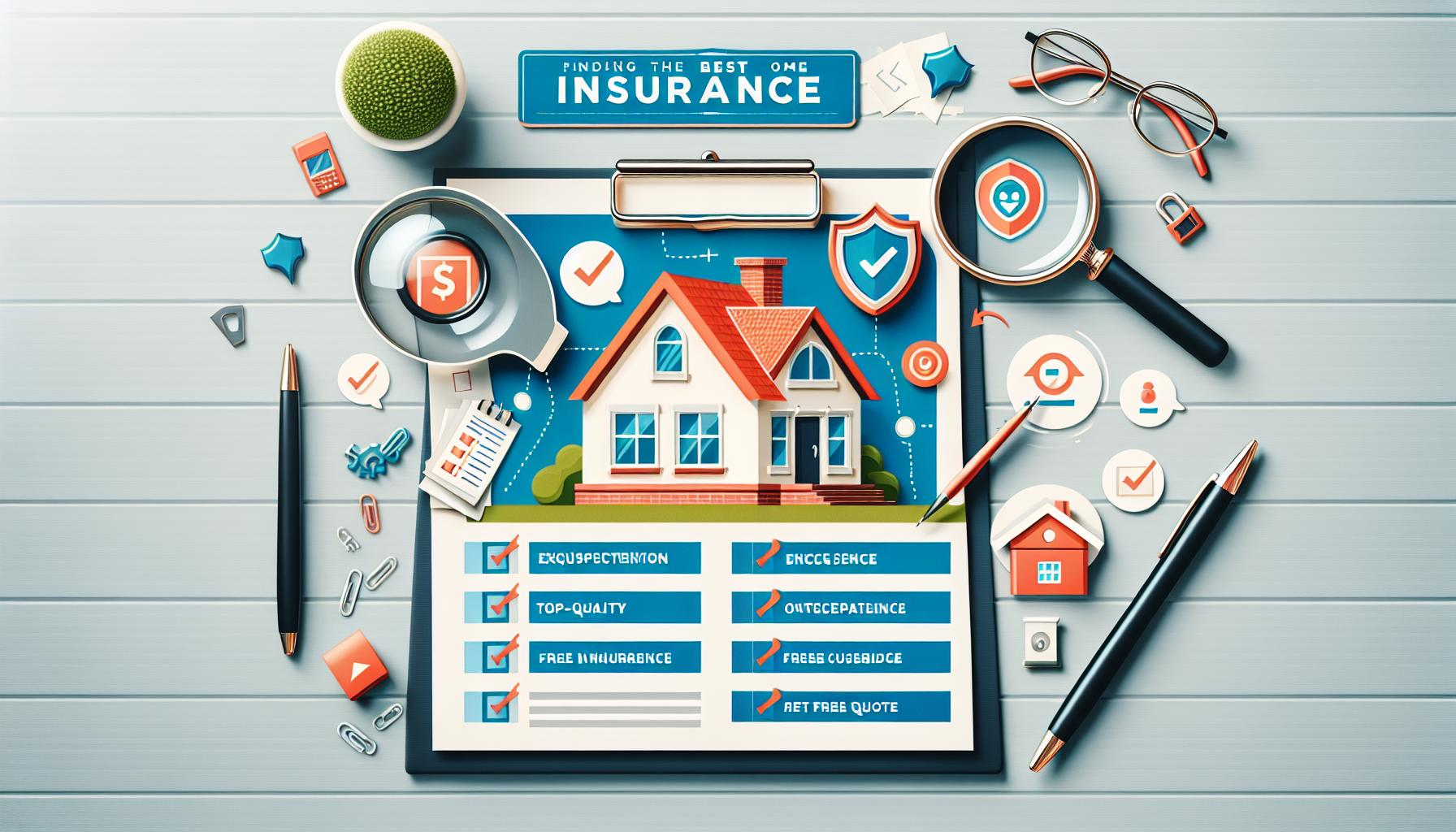
Find the Best Home Insurance: Expert Reviews & Free Quotes
Homeowners insurance serves as a shield, offering financial protection against potential damage to one’s home and personal belongings resulting from incidents such as fires, theft, and storms. It also encompasses liability coverage, safeguarding against injuries or property damages inflicted upon others.
This article aims to guide you in finding the best home insurance, walking you through expert reviews and how to obtain free quotes. It highlights essential factors like coverage understanding, the advantages of policy bundling, and what influences insurance rates, ensuring you make an informed decision.
Understanding Home Insurance Coverage
Home insurance is a multifaceted product designed to protect homeowners from a variety of risks and financial losses. At its core, home insurance policies provide coverage for the dwelling, personal property, liability, additional living expenses, and structures separate from the main residence, such as garages or sheds. The landscape of home insurance is diverse, with policies ranging from basic (HO-1) to comprehensive (HO-5) coverage, each tailored to meet different needs and preferences.
Types of Homeowners Insurance Policies
- HO-1 (Basic Coverage): Covers the structure of your home and attached features against specific perils but lacks coverage for personal property and liability.
- HO-2 (Broad Coverage): Extends protection to include personal belongings and, in some cases, liability coverage.
- HO-3 (Special Form Coverage): The most popular choice, offering broad coverage for your home, personal property, and liability on an open-peril basis for the home and named peril basis for belongings.
- HO-5 (Comprehensive Coverage): Provides the most extensive coverage, including higher limits for valuables and covering almost all perils except those explicitly excluded.
Specialized policies like condo insurance (HO-6) and renters insurance (HO-4) cater to the unique needs of condo owners and renters, respectively, ensuring a wide range of housing types can be adequately protected.
Coverage Options to Consider
When selecting a home insurance policy, it’s essential to ensure adequate dwelling coverage to rebuild your home in case of significant damage, taking into account any unique features or improvements. Additional coverage options such as extended replacement cost coverage, inflation protection, and contents replacement cost can offer further financial security. For high-value items like jewelry or firearms, additional valuables coverage is advisable. Depending on location and risk factors, considering sewer backup, ordinance or law endorsement, and flood insurance can provide comprehensive protection against a wider array of potential risks.
Additional Protection
For those seeking an extra layer of security, umbrella or excess liability coverage extends beyond the limits of standard home and auto policies, offering enhanced protection. Despite common misconceptions, homeowners living in low or moderate-risk flood areas should also consider flood insurance, as a significant portion of flood claims originate from these areas.
In conclusion, understanding the various components and options available within home insurance policies is crucial for homeowners. By carefully assessing their needs and risks, homeowners can select the best home insurance policy that offers optimal protection and peace of mind.
The Benefits of Bundling Policies
Many insurance companies incentivize customers by offering discounts when they bundle home and auto insurance, potentially leading to considerable savings. This practice simplifies managing insurance payments and minimizes the risk of overlooking a payment due date. In certain scenarios, if an event causes damage to both a home and a car, having bundled insurance may mean facing only one deductible. These discounts extend beyond just home and auto insurance, applying to other policies like motorcycle, boat, renters, or RV insurance, offering a more comprehensive savings opportunity.
Simplified Management and Payment Process
- Bundling allows for a single payment for multiple policies, streamlining the management process.
- It reduces the likelihood of missed payments, ensuring continuous coverage.
Enhanced Coverage and Savings
- Offers the convenience of insuring multiple assets such as cars, homes, rental properties, boats, and RVs under one policy.
- On average, individuals who bundle with SelectQuote save $693 annually.
Steps for Bundling Policies
- Inquire with current insurance providers about bundling benefits and compare with other companies’ bundled policies.
- Apply for the new policy, cancel the existing ones upon approval, and manage any refunds.
- Annually compare insurance coverage to ensure the best rates and coverage, adopting a thorough comparison shopping strategy.
Additional Tips for Savings
- Enhancing home security and maintaining a good credit score can further reduce homeowners insurance costs.
- Raising deductibles and making strategic home improvements are additional ways to achieve savings on homeowners insurance.
Key Factors Influencing Home Insurance Rates
Proximity and Natural Disaster Risk
- Homes closer to fire stations or water sources often benefit from lower insurance premiums due to quicker emergency response times.
- Conversely, residences in areas with higher risks of natural disasters, elevated crime rates, or significant distance from emergency services typically face increased premiums.
State-Specific Rates and Coverage Needs
- Certain states, like Oklahoma, known for frequent tornado occurrences, experience higher average annual home insurance premiums.
- The extent of coverage purchased directly impacts premiums, with more comprehensive coverage options leading to higher costs.
Credit Scores and Claim History
- In regions where permitted, a homeowner’s credit-based insurance score is utilized to gauge risk and determine premiums, with higher scores often resulting in lower rates.
- Homeowners with a record of previous claims may encounter higher premiums due to being perceived as higher risk.
Home Characteristics and Enhancements
- Older homes and those with outdated systems are more likely to incur higher premiums due to the increased risk of system failures and code violations.
- Implementing safety features or opting for a higher deductible can substantially lower premiums, although this means more out-of-pocket expenses in the event of a claim.
Additional Coverage and Home Size
- Electing for extra endorsements, such as flood or earthquake insurance, generally increases the premium but provides broader protection.
- Larger homes, due to their greater square footage, typically come with higher insurance premiums.
External Factors and Preventive Measures
- External elements like inflation, labor shortages, and supply chain disruptions can elevate rebuilding costs, subsequently raising premiums.
- Homeowners can achieve discounts by installing loss-prevention devices such as smoke alarms and deadbolt locks.
Insurance Company Policies and Location Considerations
- Insurance providers may place insured individuals into different rating “tiers” based on their underwriting guidelines, potentially affecting premiums.
- The choice of insurance company can greatly influence rates, with factors such as local crime rates, weather events, and the proximity to a fire station playing crucial roles.
Market Trends and Personal Strategies
- The overall trend of rising homeowners insurance prices, approximately 10% in 2022, reflects market disruptions and increasing costs for building materials and labor.
- Strategies like maintaining a security system, looking for multiple policy discounts, and regularly comparing policies can help homeowners manage and potentially reduce their premiums.
Finding the Right Home Insurance Provider
To ensure you find the best home insurance provider that meets your unique needs, consider the following steps:
- Review Third-Party Ratings and Customer Reviews
- Look into J.D. Power ratings for overall customer satisfaction and financial strength ratings from AM Best and Standard & Poor’s (S&P).
- Check customer reviews to gain insight into a company’s reputation and reliability.
- Compare Quotes and Coverage
- Compare quotes based on coverage, policy limits, and deductibles to determine which home insurance company offers the best value.
- Evaluate Customer Service and Digital Management Options
- Seek companies with 24/7 customer service, local agents with expertise in your geographic area, and digital management options for better accessibility.
- Investigate Claim Handling Reviews
- Refer to the J.D. Power Property Claim Satisfaction Study for insights on each company’s claim handling reviews.
- Check Available Discounts
- Before deciding on an insurance provider, explore which discounts they offer and which ones you qualify for to save on your premium.
- Consider Various Factors When Choosing
- Take into account location, home features, third-party ratings, and coverage quotes when selecting the best home insurance.
- Understand Coverage and Deductibles
- Factors to consider include coverage, deductibles, replacement cost vs. actual cash value, discounts, and customer service/claims processing.
- Utilize Consumer Reports for Unbiased Reviews
- Consumer Reports provides unbiased reviews and ratings on home insurance providers, offering insights on finding a good insurer, coverage needs, and ways to pay less for insurance.
- Review Consumer Reports’ Homeowners Insurance Buying Guide
- The guide includes information on finding a good insurer, understanding coverage needs, and reducing insurance costs.
- Consider Top Providers
- Some of the top home insurance providers include State Farm, Allstate, Chubb, Liberty Mutual, and USAA.
By meticulously following these steps, homeowners can navigate the process of finding a reliable home insurance provider that offers comprehensive coverage and excellent customer service, ensuring peace of mind and financial protection.
Conclusion
Navigating the maze of home insurance options necessitates a careful balance of understanding coverage basics, recognizing the benefits of policy bundling, and acknowledging the factors that influence insurance rates. By dissecting these components, homeowners are equipped to make informed decisions that align with their individual needs and risk profiles. The essence of finding the right home insurance lies not just in securing financial protection but in ensuring peace of mind amidst the myriad of potential risks homeowners face.
In the pursuit of tailor-fitting home insurance coverage, emphasizing the importance of thorough comparison, consideration of bundling benefits, and weighing factors beyond premium costs are paramount steps towards financial prudence. The journey towards the ideal home insurance policy, while intricate, offers a path of security, safeguarding your most significant investment against unforeseen adversities. Armed with the guidance provided, homeowners are better prepared to select a home insurance provider that not only meets their coverage needs but augments their life’s stability and comfort.


